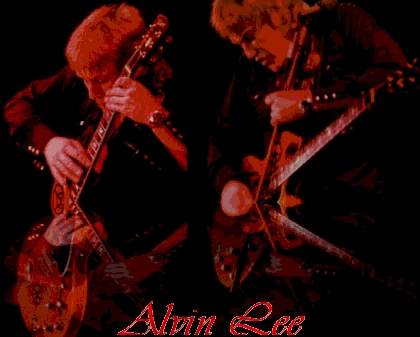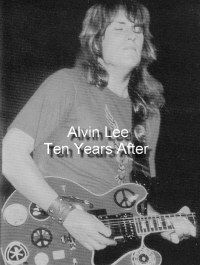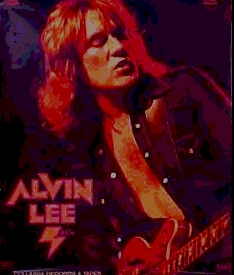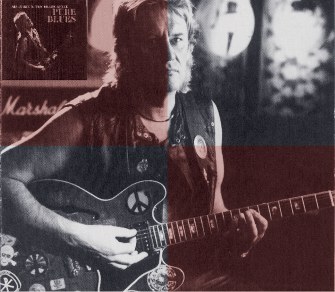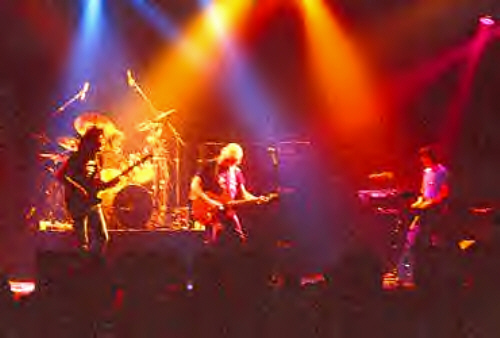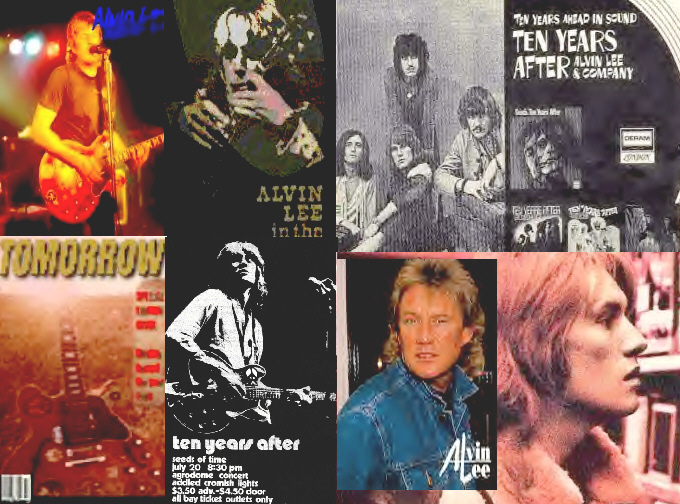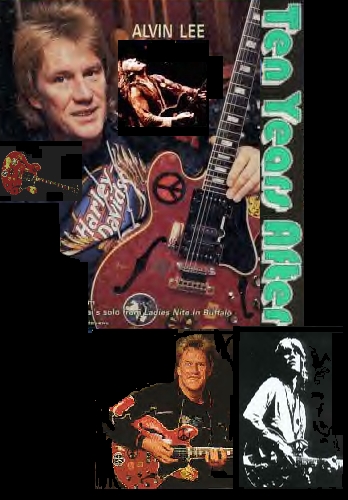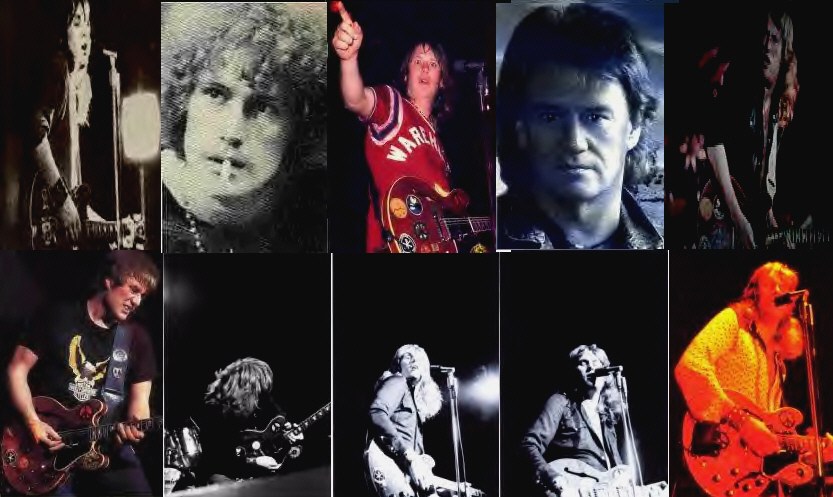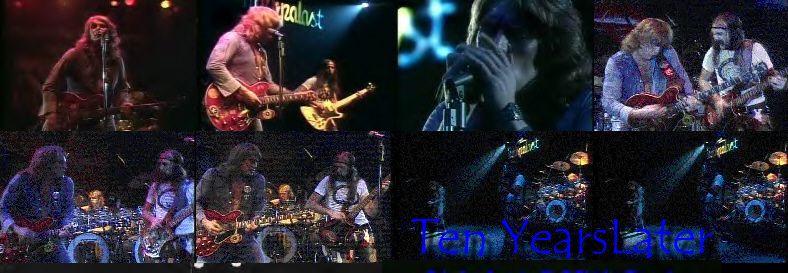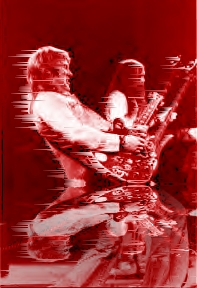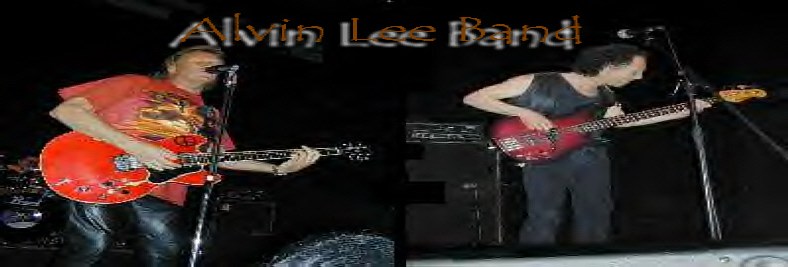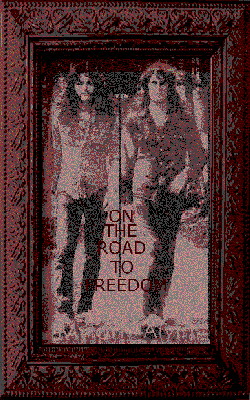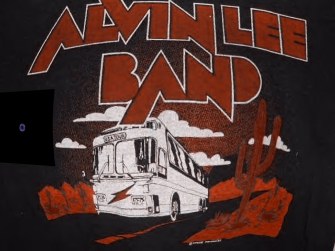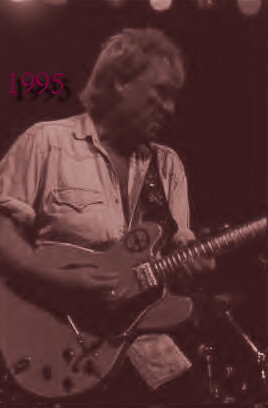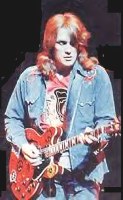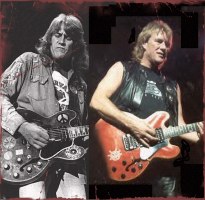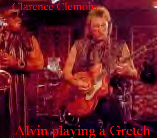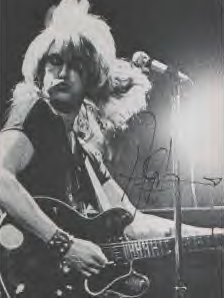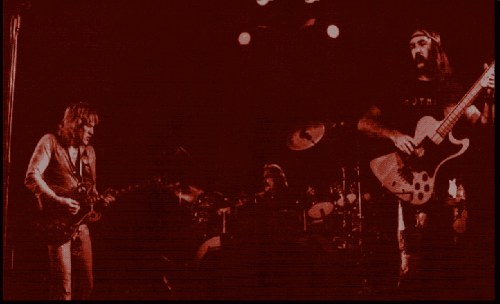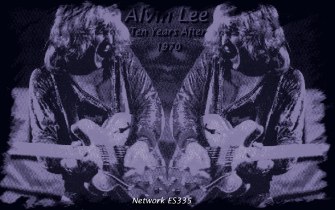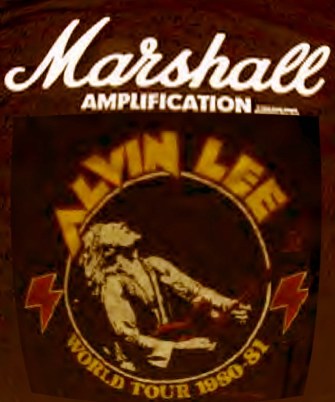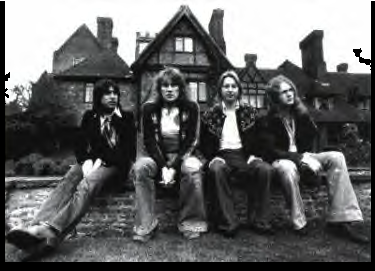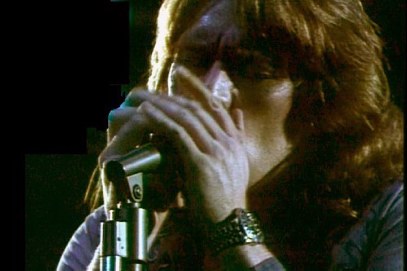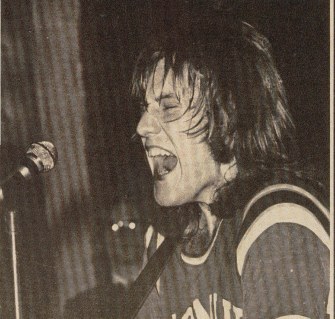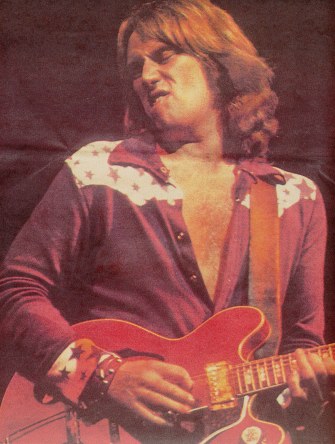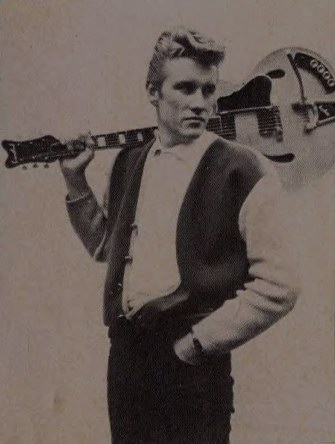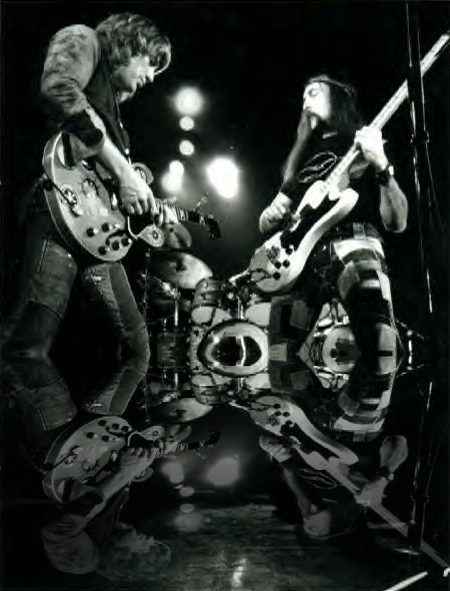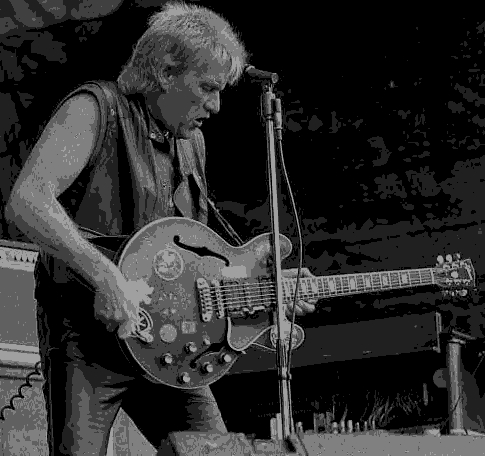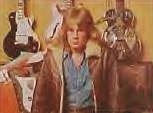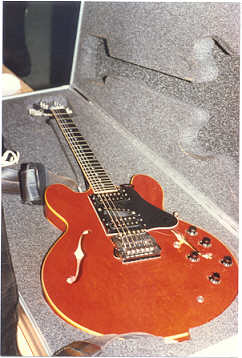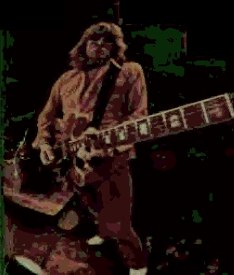Alvin Lee
In 1966, the same year that Cream and Jimi Hendrix made their British debuts
it seems Ten Years After suddendly appeared out of the pubs and into their own spotlight as a main attraction on stages across England,
documenting a new era in The 2nd Wave Of The British Blues Invasion Into Rock Music.
Ten Years After took the American blues classics and added extra volume, jazz extensions
and their own unique improving twist to create a high point in the futuer development of Rock-N-Roll
Ten Years After featured the incredibly phrased guitar work of Alvin Lee,
a player who merged jazz dexterity with 50's rock and blues grittiness.
To some fault of his own, he never achieved the same notoriety as his comtemporaries
Jimi Hendrix, Eric Clapton, Jeff Beck, or Jimmy Page.
Alvin himself constantly downplays his own ability,
forever trying to outrun the image of himself and Ten Years After in a state of pure pyrotennic pyschedelic oblivion at Woodstock in 1969,
which still to this day leaves many guitarists in complete awe and admiration
Voted the East Midlands' best guitarist in Total Guitar Magazine's
poll of the greatest 12 British guitarists. [July 2001]
10 Questions and Answers
5' 11"
I've asked, He dosen't wanna do 10 Questions
Do you feel your part in "Woodstock'. helped your career as a musician or not? I mean, it put you in the public eye,
but did you not find you were playing more and more requests, and less and less of the things you actually wanted to do?
Alvin Lee:
Well, we never play requests! We never play anything other than what we want to do.
However "Woodstock" did have a considerable effect.
When we did "Woodstock" we didn't realise it was going to be such a big thing, just a festival which we had to arrive at on time.
It wasn't until we got into helicopter, and flew in, that we realised what a big thing it was.
Even then, we weren't to realise how much world attention it would get, which it did.
It was on national news in America and everything, and that's more than I expected, so the kind of publicity we got from being in the "Woodstock" film initially, like, gave us a boost in popularity.
A lot more people had heard us, whereas before Woodstock, we were still playing the concert halls and we were still selling enough albums.
We were doing really well.
After ""Woodstock", well we found that more people were coming to the concert halls, more people were buying the albums.
But it was on the strength of 'Going Home, which is a nasty situation. You can't take control of it.
One of the UK's best guitarists
In the late 1960s, one of the guitarists most admired for his technique was Alvin Lee. Molded by a broad range of musical styles, his albums from 1967 to the 1970s with "Ten Years After" {Ric Lee, Leo Lyons, Chick Churchill} showcase his fast and fluent improvisational blues style that contained jazz and country elements.
Among musicians, one of the main criticisms leveled at Alvin's playing ability is his "uncontrolled" speed, especially in the phrasing of his licks. He explains, "I'm not conscious of the speed. It's a feeling, an emotion that my fingers lodge upon the neck and I can get fast, but it's not my motive. My motive is displaying a voice through the fingerboard."
To achieve his speed, Alvin used the mind-boggling method of repetition until each lick became more of a reflex than a thought. There is one point, though, where his speed is a conscious thought, and that is when Alvin is producing a musical crescendo. "Then," he says, "my style is more neurotic and is basically a fingerboard pattern from note memory which found its way into an explanation of how I feel the music should be."
As there are many kinds of people,
there are many kinds of superstars.
Many have been created by media, many by music.
Several owe it all to looks, and a few to backers.
Regardless of the means by which a superstar is created,
the end inevitably results in a different person.
For Alvin Lee,
who'd been out front of his group Ten Years After
since their first American tour in 1968,
the role of superstardom
is one which he assumed
only with reluctance,
only in a secondary vein,
and very much to aviod hassles
.
Alvin Lee was fast, the epitome of the British speed demon guitarists, but his speed and his smile were intertwined forever.
The one made him salable, the other made him identifiable; but we all know what too much speed does for the teeth.
Still, without those alabaster incisors, Ten Years After might have lent new meaning to the concept of facelessness,
which dominates so much of the rest of British blues. For all its limits,
Alvin Lee's twin talents gave them a head start over the various Foghats, Savoy Browns and Mayalls.
Lee has personality, if not charisma, and the sense of humor— not just fun, which is intimately tied to work— that ought to go with it.
It is difficult to imagine even such an inspired British bluesman as Eric Clapton having the ironic self-perspective to tote a watermelon over his shoulder as he trudged off the Woodstock stage, in full view of 500,000 fans and half as many cameras.
Alvin Lee's flashing smile was as important as the white heat of his guitar runs.
What's the deal with the Statocaster pick-up added to your ES335 guitar?
Humbucker & Strat. Sounds like a really cool law office.
I always liked the Strat sound but when I play a Strat I find my little finger on the right hand keeps turning the volume down unintentionally. I figured that by adding a Strat back PU to my 335 I would have the best of both worlds.
I've always liked messing about with electronics. I built my own amp and speaker cabs when I was 16 and as soon as I got my first 335 I took off the humbucker covers to get a bit more edge and turned the bridge PU round the other way for extra bite.
I remember when I first met Les Paul and told him about this he said " I do all this work to make pick ups that dont hum by putting screens on them and the first thing you do is take them off again" He did have to admit though when I challenged him that he used to do the very same kind of thing to all his equipment in the early days. It's the result of an experimental mind and an inborn instinct to fiddle. Without that I doubt if Les would ever have made an 8 track tape recorder out of a Cadillac flywheel... Respect!!!
The Strat PU is wired between the jack socket and the 3 way toggle switch. If you solder to the centre position on the switch you can bring the Fender PU in to either or both Humbuckers with the added Volume pot. You have to try different Strat PU's to find a good match to the Humbuckers as they all vary a bit depending on model types and age.
Working on the 335 electronics is a bit like keyhole surgery I used to fasten guitar strings to the pots, toggle switch and jack socket before dropping them into the body and pulling them out the F holes. That way there is a good chance of getting them back in place again later.
Loads of fun when one falls off!!!!!!!!!!!!
Alvin
Response is reprinted from AlvinLee.Com guestbook, My thanks to Toni Franklin 11/08/2002
Alvin Lee is still capable of delivering spellbinding fretboard mastery that routinely leaves audience members in awestruck admiration.
Alvin Lee, the most under-rated guitarist in music, what's your opinion?
Captian Speedfingers? "I don't think so, No way. Thre are plenty of guitarists faster than me. Django Reinhardt was faster than me & he only had 2 working fingers, it's a silly title anyway, I never was, I never will be and who's counting anyway!" A.Lee 1984
USA TOUR
Click below to visit R. Bennett's photo site
Alvin Lee Band 1987, New York
Solo projects
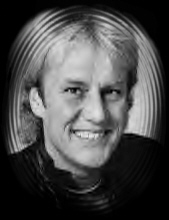
Alvin Lee
Sometimes A Memory Ain't Enough - 1972 Mercury (with Jerry Lee Lewis)
On The Road To Freedom - 1973 Chrysalis (with Mylon Lefevre)
Dark Horse - 1974 Apple/Parlophone (with George Harrison)
The Place I Love - 1974 Dark Horse (with Splinter)
In Flight - 1974 Chrysalis (as Alvin Lee & Co.)
Pump Iron! - 1975 Chrysalis
Anniversary Special - 1975 CBS (with Earl Scruggs)
Peter And The Wolf - 1975 RSO
20th Anniversary Of Rock 'n Roll - 1976 RCA (with Bo Diddley)
One Of The Boys - 1977 Polydor (Roger Daltrey)
Bullinamingvase - 1977 Harvest (with Roy Harper)
Let It Rock - 1978 Chrysalis
Rocket Fuel - 1978 RSO (with Ten Years Later)
Ride On - 1979 RSO (with Ten Years Later)
Free Fall - 1980 Atlantic (with The Alvin Lee Band)
RX5 - 1981 Atlantic (with The Alvin Lee Band)
Detroit Diesel - 1986 21 Records
Techno Prisoners - 1987 RCA (with Roger Chapman - German release)
Night Of The Guitar - 1989 I.R.S.
Walking The Cat - 1989 SPV (with Roger Chapman - German release)
Diamond Days - 1990 MCA (with The Outfield)
Liebe - 1991 Warner Brothers (with Peter Maffay)
Rockeye - 1992 MCA (with The Outfield)
Under No Obligation - 1992 Polydor (with Roger Chapman)
Waiting In The Wings - 1992 Line (with Chris Farlowe)
Live 1990 - 1992 Demon
Zoom - 1992 Domino
Nineteen Ninety Four - 1993 Magnum
Message To Man - 1995 Inakustik (with Sidney Shelby - German release)
Live In Vienna - 1995 Coast To Coast
Real Live - 1996 Overture (with Hank Davison)
Tracks Of The Past - 1996 Via (with Rik Meyer and Java Project)
|

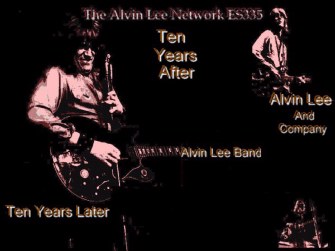
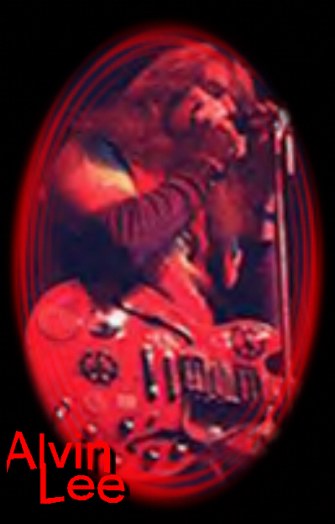
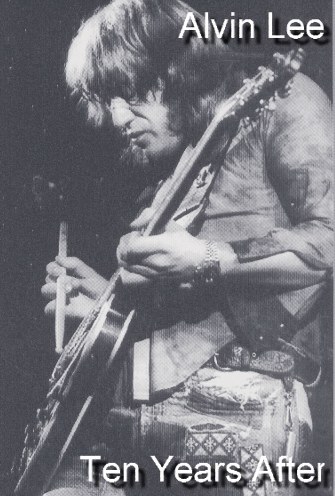
1975 TYA tour the US for the 28th time
TEN YEARS LATER 1978
Trivia Question:
May 1976, Which guitarist made a guest appearance in Alvin Lee & Company's concert at Roundhouse, London?
Hidden Answer-> JEFF BECK <=Were you right?
Guitars come and go
There are many more that Alvin has played but aren't listed here.
Gibson 335, 345, Les Paul, Fender Stratocaster, Rickenbacker, Gretch, Tokai, Heritage, Harmos 8 string Sacred Steel, Zemaitis, Yamaha, Scott Blues Dawg, National
Solo material
